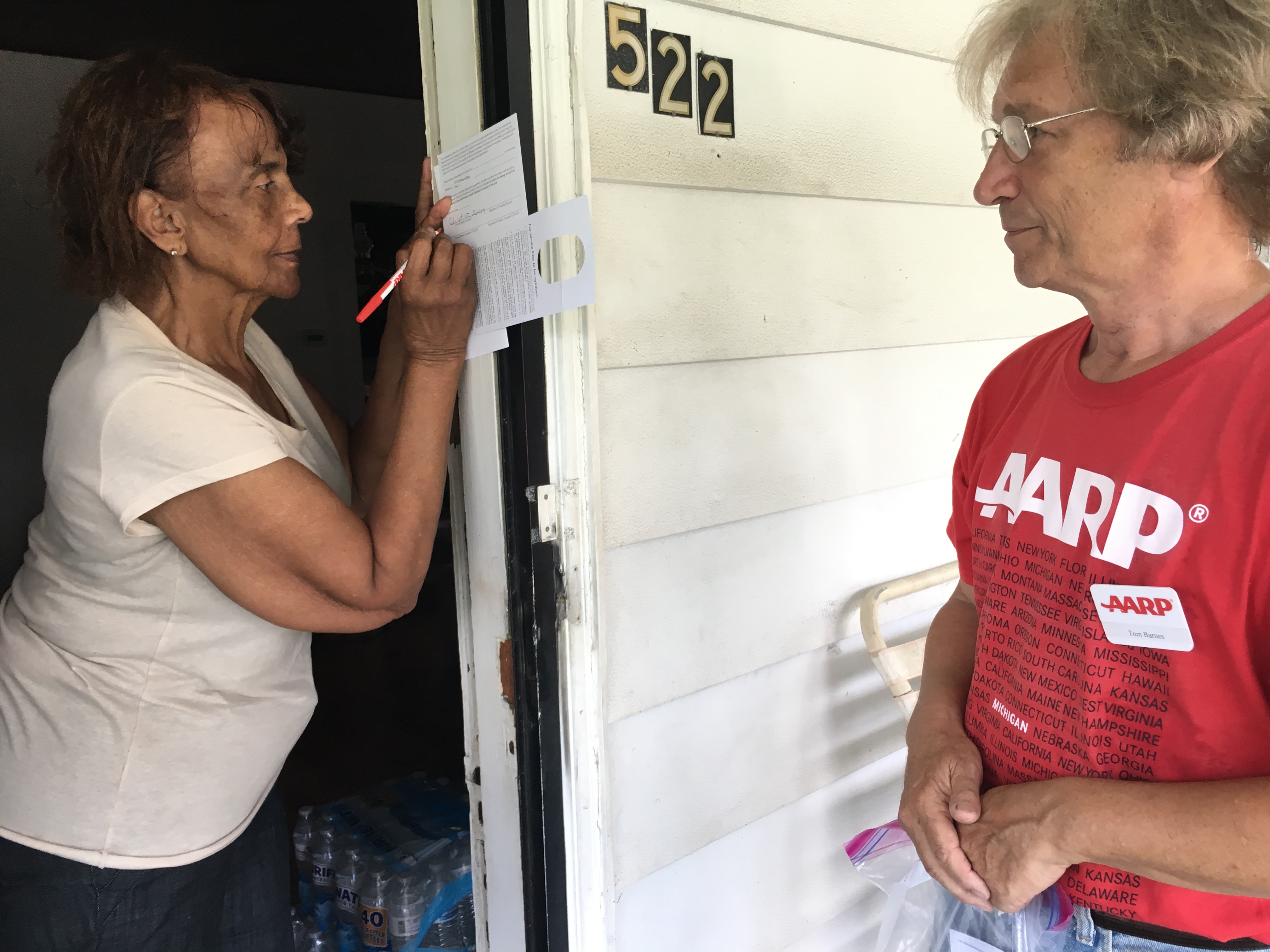AARP Eye Center

Undrinkable
During the fall of 2015, whether you lived in Michigan or thousands of miles away, it was hard to open a newspaper or turn on the TV without hearing about the water crisis in Flint. The devastating story gripped the headlines, and as government officials passed the blame and pointed fingers, real people were suffering.
Video: AARP helps out in Flint: https://vimeo.com/aarpbroadcast/review/228121542/04ec4b8b08
Residents showed up to water crisis forums with samples of the frighteningly brown and murky water flowing from their taps. Reports surfaced of children with abnormally high lead levels. People were afflicted with mysterious rashes and illnesses.
“At a community meeting, one woman opened her mouth and asked me to take a picture of the open sores inside,” recalled Mark Hornbeck, AARP Michigan Associate Director of Communications.
Forgotten in Flint
While the Flint crisis had received national attention, the AARP Michigan team noticed that there was little focus on the unique needs of older adults.
AARP Michigan began working with volunteers to deliver bottled water to homes without safe drinking water. Seeing the devastation firsthand was not easy.
“Our hearts went out to these folks. There is no doubt we had to engage,” said Hornbeck. “If you don’t have drinkable water, how ‘livable’ is Flint? We saw this as something we had to do.”
Asking the Community What They Need
In Flint, the AARP Michigan team was committed to helping, but they knew they had to do so thoughtfully. The AARP team wanted to engage in a way that the community supported. They made a strategic decision that they would ask the residents of Flint what they needed.
“We didn’t just ride into town on our steeds and tell people what we were going to do,” emphasized Hornbeck. “The residents of Flint would tell us what they needed.”
With the help of national office partners including AARP Foundation, the AARP Michigan team organized two listening sessions, specifically geared toward older adults. They captured the perspectives of more than 80 Flint residents. The listening sessions were followed by a needs assessment of 700 residents aged 60 years or older. That needs assessment resulted in resounding agreement that replacing the pipes that lead to their homes was residents’ top priority.
A Trusted Messenger
The precursor to pipe replacement was securing signed consent forms from residents, and this provided a clear role for AARP Michigan. At a time when there was so little trust in government officials, AARP was a trusted messenger with the capacity to both collect consent forms and help the community understand why they were necessary.
The AARP Michigan volunteer force played a key leadership role in organizing and executing the massive task of contacting thousands of homes to secure consent forms. There were even volunteers who used canes and walkers who still wanted to go door to door to help the people of Flint. “The volunteers were extremely dedicated,” noted Kimberley Bishop, Michigan Associate State Director of Community Outreach. “They’ve been out in rain and the cold and never complained. The level of commitment and dedication is heartwarming.”
The involvement of the Michigan team did not stop with door-to-door outreach. They became integrated into the community and partnered with a diverse group of public and private entities. These included the Governor’s Flint Water Interagency Coordinating Committee (FWICC), Department of Environmental Quality (DEQ), the FAST Start (pipe replacement) program, the Michigan Department of Health and Human Services (DHHS), the Flint Mayor’s office, the Valley Area Agency on Aging, and faith-based organizations.
The AARP team also organized an earned and paid media strategy to help the community understand the pipe replacement process. This included a TV buy in the Flint market with ads featuring AARP Michigan State Director Paula Cunningham who quickly became a local celebrity. “As we went door to door people were asking us, ‘do you know Paula?’” recalled Bishop.
To date AARP Michigan has contacted more than 6,000 homes in the city, whether in-person or by mail. This astounding number was made possible by a committed AARP volunteer force, and a reputation and strategy that built trust in the community.
Gratitude from Flint
The people of Flint are still dealing with the ramifications of the water crisis, and AARP Michigan is committed to continuing its presence in the community. The partnerships and reputation built during the water crisis work have provided opportunities for other community work, building relevance for current and potential members.
AARP Michigan is cementing their presence in Flint and enriching lives with experiences like a Movies for Grownups screening, a Fraud Watch Network presentation at the county fair, veterans outreach, intergenerational events with a local fraternity, and the faith-based community. And AARP will continue to be a driving force in the response to the water crisis; they have a goal of reaching 6,000-8,000 homes for the next two years.
The most meaningful feedback comes from the real people touched by AARP’s work: the residents of Flint. Some of them sat on porches waiting for the red-shirted AARP teams to arrive. One told a volunteer that AARP was doing “God’s work.”
“One man stopped me while we were going door to door,” recalled Bishop. “He pulled his AARP card out of his wallet to show he was a member. He thanked us profusely for the difference we are making in his hometown of Flint.”
https://vimeo.com/aarpbroadcast/review/228121542/04ec4b8b08























































